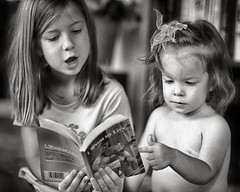
One-to-One computing is already here, it's just that we can't experience it on a large scale, until we accept the validity of cell phone technology in the classroom. Here are just a few examples of the potential of this micro-computer technology, should we allow students to bring wifi enabled mobile communicators to school:
1]
Photography: Students will leverage cell phone cameras to document science experiments; to create photo essays; to archive learning experiences...
2]
Cloud Apps: Wifi enabled cell phones will provide access to
instant news; collaborative
wikis; and a wide variety of other web-based documents. What's more, access to
documents will allow both reading & writing.
3]
Synchronous Audio: Whether linking with classmates; or connecting with relevant real world experts, the potential for free communication via
Skype and other wifi services will further erode classroom walls.
4]
File-sharing: Savvy teachers will engage personal computers as
Bluetooth servers to automate the delivery of text, audio, and mixed media content to student hand-helds. For examples of the potential for this technology, visit
Jarrod Robinson's blog.
5]
Geotagging: As global positioning technology (GPS), becomes common on mobile phones, it will be used to post text, audio and photo content with automatic tags to geographic locations. Partnered with
Quick Response codes (QR tags) the resulting cloud content can be drawn to hand-helds through the snapping of photos.
6]
Podcasting:
Recent studies are demonstrating the value of recordings to student learners who are growing up in a world of random access. With the potential for retrieving content produced by both students and teachers, the use of portable audio as a
universal design for learning, is long overdue.
7]
Streaming: Besides allowing handhelds to view streaming content, apps on the
iPhone and other modern mobile phones, now allow live audio and video
broadcasting. Classroom channels will soon share learning with parents and other interested community members.
8]
Tweet-notes: Two-way
Twitter feeds now available via mobile clients, can connect students to students; classrooms to classrooms; teachers to teachers. Realizing that text message conversations provide opportunities to save, share and search ideas, we may soon be using
Twitter Search as often as we use
Google.
9]
Learning Through Gaming: Video game producers have been slow to meet educational needs with their hand-held devices, but
Flash-based learning activities are becoming ubiquitous on the wider web. As mobile browsers evolve to represent this content, every classroom will have open access to engaging learning apps.
10]
The World at Hand: The day's
global news; electronic libraries
; and user-generated content will be available to each student. With the sum of all human knowledge in the palm of the hand, educators will be forced to address issues of validity and bias, and will have to re-think how students can demonstrate their learning.
I for one, await the advent of the open phone test!
What other educational changes can we expect, once we welcome mobile phones in the regular classroom?
Photo Credit: Jason Jerde
 Last week, I had the good fortune of stumbling across 'The Essential Man' an Esquire article that reconnected me with storied film critic, Roger Ebert. The article prompted me to locate Roger Ebert's online journal, where he seems to be saying more than he ever did 'from the balcony'.
Last week, I had the good fortune of stumbling across 'The Essential Man' an Esquire article that reconnected me with storied film critic, Roger Ebert. The article prompted me to locate Roger Ebert's online journal, where he seems to be saying more than he ever did 'from the balcony'. 












